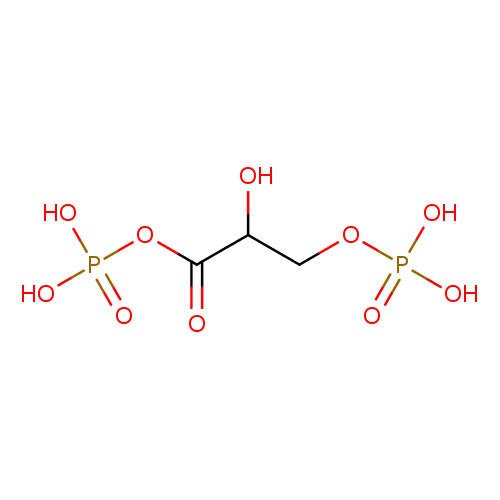|
Record Information |
|---|
| Version |
1.0 |
|---|
| Update Date |
1/22/2018 11:54:54 AM |
|---|
|
Metabolite ID | PAMDB110349 |
|---|
|
Identification |
|---|
| Name: |
1,3-bisphospho-D-glycerate |
|---|
| Description: | Tetraanion of 3-phospho-D-glyceroyl dihydrogen phosphate arising from deprotonation of both phosphate groups. |
|---|
|
Structure |
|
|---|
| Synonyms: | -
3-phospho-D-glyceroyl-phosphate
-
3-phosphoglyceroyl-P
-
P-glyceroyl-P
-
phosphoglyceroyl-P
-
3-phosphoglyceroyl-phosphate
-
3-P-glyceroyl-P
-
DPG
-
13-DPG
-
glycerate 1,3-bisphosphate
-
3-phosphonato-D-glyceroyl phosphate
|
|---|
|
Chemical Formula: |
C3H4O10P2
|
|---|
| Average Molecular Weight: |
262.01 |
|---|
| Monoisotopic Molecular
Weight: |
265.9592694978 |
|---|
| InChI Key: |
LJQLQCAXBUHEAZ-UWTATZPHSA-J |
|---|
| InChI: |
InChI=1S/C3H8O10P2/c4-2(1-12-14(6,7)8)3(5)13-15(9,10)11/h2,4H,1H2,(H2,6,7,8)(H2,9,10,11)/p-4/t2-/m1/s1 |
|---|
| CAS
number: |
1981-49-3 |
|---|
| IUPAC Name: | (2R)-2-hydroxy-1-oxopropane-1,3-diyl bis(phosphate) |
|---|
|
Traditional IUPAC Name: |
1,3-bisphosphoglycerate |
|---|
| SMILES: | C(C(O)C(OP(=O)([O-])[O-])=O)OP(=O)([O-])[O-] |
|---|
|
Chemical Taxonomy |
|---|
|
Taxonomy Description | This compound belongs to the class of chemical entities known as acyl monophosphates. These are organic compounds containing a monophosphate linked to an acyl group. They have the general structure R-CO-P(O)(O)OH, R=H or organyl. |
|---|
|
Kingdom |
Chemical entities |
|---|
| Super Class | Organic compounds |
|---|
|
Class |
Organic acids and derivatives |
|---|
| Sub Class | Organic phosphoric acids and derivatives |
|---|
|
Direct Parent |
Acyl monophosphates |
|---|
| Alternative Parents |
|
|---|
| Substituents |
- Acyl monophosphate
- Monoalkyl phosphate
- Glyceric_acid
- Alkyl phosphate
- Monosaccharide
- Secondary alcohol
- Monocarboxylic acid or derivatives
- Carboxylic acid derivative
- Organic oxygen compound
- Organic oxide
- Hydrocarbon derivative
- Organooxygen compound
- Carbonyl group
- Alcohol
- Aliphatic acyclic compound
|
|---|
| Molecular Framework |
Aliphatic acyclic compounds |
|---|
| External Descriptors |
Not Available |
|---|
|
Physical Properties |
|---|
| State: |
Solid |
|---|
| Charge: | -4 |
|---|
|
Melting point: |
Not Available |
|---|
| Experimental Properties: |
| Property | Value | Reference |
|---|
| Melting Point | Not Available | Not Available | | Boiling Point | Not Available | Not Available | | Water Solubility | Not Available | Not Available | | LogP | Not Available | Not Available |
|
|---|
| Predicted Properties |
|
|---|
|
Biological Properties |
|---|
| Cellular Locations: |
Not Available |
|---|
| Reactions: | |
|---|
|
Pathways: |
|
|---|
|
Spectra |
|---|
| Spectra: |
|
|---|
|
References |
|---|
| References: |
- Nakayama Y, Kinoshita A, Tomita M: Dynamic simulation of red blood cell metabolism and its application to the analysis of a pathological condition. Theor Biol Med Model. 2005 May 9;2(1):18. [15882454 ]
- Fujii H: [Red cell glycolytic intermediates] Nippon Rinsho. 1995 Mar;53 Su Pt 2:234-8. [8753225 ]
- Sayed A, Matsuyama S, Inoue K, Alsina J, Cai F, Chen J, Inouye M: ATPase and GTPase activities copurifying with GTP-binding proteins in E. coli. J Mol Microbiol Biotechnol. 2000 Jul;2(3):261-3. [10937433 ]
- Inoue H, Moriyasu M, Hamasaki N: Metabolism of 3-phosphoglyceroyl phosphate in phosphoenolpyruvate-enriched human erythrocytes. J Biol Chem. 1987 Jun 5;262(16):7635-8. [3584133 ]
- Fabry ME, Nagel RL: Heterogeneity of red cells in the sickler: a characteristic with practical clinical and pathophysiological implications. Blood Cells. 1982;8(1):9-15. [7115982 ]
- Flachner B, Varga A, Szabo J, Barna L, Hajdu I, Gyimesi G, Zavodszky P, Vas M: Substrate-assisted movement of the catalytic Lys 215 during domain closure: site-directed mutagenesis studies of human 3-phosphoglycerate kinase. Biochemistry. 2005 Dec 27;44(51):16853-65. [16363799 ]
- Carreras J, Bartrons R, Climent F, Cusso R: Bisphosphorylated metabolites of glycerate, glucose, and fructose: functions, metabolism and molecular pathology. Clin Biochem. 1986 Dec;19(6):348-58. [3555887 ]
- Fokina KV, Dainyak MB, Nagradova NK, Muronetz VI: A study on the complexes between human erythrocyte enzymes participating in the conversions of 1,3-diphosphoglycerate. Arch Biochem Biophys. 1997 Sep 15;345(2):185-92. [9308888 ]
- Jovanovic S, Du Q, Crawford RM, Budas GR, Stagljar I, Jovanovic A: Glyceraldehyde 3-phosphate dehydrogenase serves as an accessory protein of the cardiac sarcolemmal K(ATP) channel. EMBO Rep. 2005 Sep;6(9):848-52. [16082386 ]
- Oimomi M, Yoshimura Y, Kubota S, Tanke G, Takagi K, Baba S: Effect of hydrocortisone on the synthesis of 2,3-diphosphoglycerate in human erythrocytes. Transfusion. 1982 Jul-Aug;22(4):266-8. [7101418 ]
- Joao HC, Williams RJ: The anatomy of a kinase and the control of phosphate transfer. Eur J Biochem. 1993 Aug 15;216(1):1-18. [8365395 ]
|
|---|
| Synthesis Reference: |
Not Available |
|---|
| Material Safety Data Sheet (MSDS) |
Download (PDF) |
|---|
|
Links |
|---|
| External Links: |
|
|---|


